Betws Gwerful Goch is a village some five miles north-west of Corwen, and was originally in the ancient county of Merionethshire. In 1974 it was transferred to Glyndŵr District in Clwyd by the Local Government Act 1972 and during 1996 became part of Denbighshire. The men of the village who fell during both World Wars are commemorated on a war memorial which is located within the graveyard for Capel-y-Gro Methodist Chapel, which lies on the boundary between the Parishes of Llanfihangel Glyn Myfyr and Betws Gwerful Goch. As the village was in Merionethshire during both wars, I am putting it in the Merionethshire section of the website.
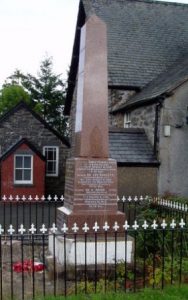
The Great War, 1914-1918
Robert Austin, Private, 204390, Middlesex Regiment. Robert was the son of William and Margaret Austin, of Pant Afallen, Betws Gwerful Goch. He lived at Garthisey, Llandrillo prior to enlisting at Dolgellau into the 2/7th Battalion, Middlesex Regiment on 3 February 1917. After completing his training, Robert embarked at Folkestone on 13 September 1917 and landed in Boulogne later that day, before joining the 3/10th Battalion, Middlesex Regiment, which was at Ypres attached to 10 Brigade, 4th Division. The Division had moved to Ypres in September following service in the Arras sector and was thrown into the Passchendaele offensive on 29 September soon after reaching Belgium and Robert probably saw his first taste of battle during an attack by his new battalion that day. The battalion moved back to Leipzig Camp for a rest on 1 October, and on the night of 3/4 October moved back into the line near Langemarck, to take part in an assault to the north-east of the battered remains of the village. Robert was badly wounded in the back during fighting near Eagle Trench early in the assault, and died of his wounds at the 61st Casualty Clearing Station on 5 October 1917, aged 21. He is buried in Dozinghem Military Cemetery, Belgium.
Emrys Bodfan Davies, Private, TR/4/48657, South Wales Borderers. Emrys was the son of David John Davies and Mary Grace Davies, of Bodynlliw, Betws Gwerful Goch. He was called up for military service in March 1917, and appealed for exemption for service at the Corwen Tribunal, but his appeal was rejected, so Emrys was sent to Dolgellau where he attested into the Training Reserve. After completing his training at Kinmel Park he was posted to France in April 1918, joining the 10th Battalion, South Wales Borderers, which was attached to 115 Brigade, 38th (Welsh) Division. The Division had just taken over the Bouzincourt sector of the line north of Albert on the Somme, and held the sector over the months leading up to the launch of the great offensive across the flooded valley of the River Ancre on 21 August 1918. The Division captured Thiepval Ridge and Pozieres village that day, before taking part in the great advance towards the Hindenburg Line. Emrys was wounded and taken prisoner by the Germans on 29 August 1918, during fighting near Delville Wood, and was incarcerated in Limburg, Germany until after the Armistice. He returned home in very poor health, and with a fractured ankle, on 10 January 1919, so was hospitalised. Emrys then contracted sepsis and died at the King George V Hospital, Stamford, London of sepsis on 15 March 1919, aged 20. His remains were brought home for burial in Capel y Gro, Betws Gwerful Goch.
David Ellis, Private, 30453, Royal Welsh Fusiliers. David was the son of Hugh and Jane Ellis, of Pencraig Bach, Betws Gwerful Goch. He worked as a farm servant at Gwyddelwern prior to enlisting at Welshpool into the 2/1st Battalion, Montgomeryshire Yeomanry on 17 September 1914. David remained on home service before embarking at Devonport aboard the SS Transylvania on 20 September 1916 and disembarked in Salonika three weeks later, to join the 11th Battalion, Royal Welsh Fusiliers. The battalion had been in Salonika since 5 November 1915 attached to 67 Brigade, 22nd Division, taking part in the campaign against the Austrian and Bulgarian forces which had attempted to invade Greece. As was often the case with troops in Salonika, David suffered several spells of sickness whilst in Salonika over the coming months. He was killed in action in Salonika on 10 June 1918, aged 24. David is buried in Karasouli Military Cemetery, Greece.
Robert Oliver Hughes, Corporal, 147478, Canadian Infantry. Robert was born on 30 June 1892, the son of John and Margaret Hughes of Cefn Ceirch, Betws Gwerful Goch. He had emigrated to Canada in 1911, and attended Manitoba Agricultural College, Winnipeg, from 1912, studying Agriculture and then Engineering. He became superintendent of drainage at the College Farm and was preparing for his final exams when he enlisted at Winnipeg into the 78th Battalion, Canadian Infantry on 8 July 1915, after having already served with the Fort Garry Horse (Militia), which worked in a similar vein to the British Territorial Army. After almost three months of training, Robert embarked at Montreal aboard the SS Corsican on 28 September 1915, and upon arrival his battalion moved to Shorncliffe Camp. On 29 February 1916 Robert was posted to France, among a number of reinforcements for the 10th Battalion, Canadian Infantry. The battalion was attached to the 2nd Brigade, 1st Canadian Division and was stationed near Ypres, in positions to the south of Hooge and the Menin Road. On the morning of 2 June 1916, the Canadians came under an intensive artillery bombardment, and then four underground mines were blown before the German infantry attacked the Canadian lines. The Germans captured Mount Sorrel and Hill 61, but failed to take advantage of their successes, and the Canadians counter-attacked the following day. Robert had been severely wounded during the German attack of 2 June, after his battalion had been ordered forward to plug a hole in the line. He was evacuated to the casualty clearing station at Remy Sidings where he died of his wounds on the following day, 3 June 1916, aged 24. He is buried in Lijssenthoek Military Cemetery, Belgium.
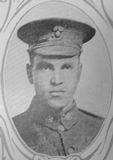

Robert Hughes Jones, Lance Corporal, 17978, Royal Welsh Fusiliers. Robert was the son of Ellis and Ann Ellen Jones, of Fron Goch, Betws Gwerful Goch. He lived at Ty Newydd Isa and worked as a farm labourer prior to the war, and enlisted at Corwen into the 13th Battalion, Royal Welsh Fusiliers. The battalion was raised at Rhyl, moving to Llandudno to join 128 Brigade, 43rd (Welsh) Division. On 28 April 1915 the formation became 113 Brigade, 38th (Welsh) Division and moved to Winchester for further training before landing in France on 1 December 1915. The entire Division moved to the Fleurbaix sector, where it was initiated into trench warfare. During June 1916 the Division marched south to the Somme, and on 7 July 1916 attacked Mametz Wood. The initial attack failed, and it was three days later, on 10 July, that a fresh attack was mounted. After two days of heavy hand to hand fighting within the wood, the Germans withdrew, and the battered Welshmen moved via Hebuterne to Boesinghe, on the Yser Canal, where it remained until launching its attack on Pilckem Ridge on 31 July 1917. The 15th Welsh remained in the line, and also took part in the Battle of Langemarck, before the entire Division was moved to positions near Armentieres over the winter. After the Germans launched their offensive on the Somme on 21 March 1918, the Division was moved back to the Somme, and took up positions north of Albert, around Aveluy Wood where it remained until launching its offensive across the flooded Ancre Valley on 21 August 1918, as part of the great drive towards the Hindenburg Line. By 8 October 1918 the Division was near Villers-Outréaux, facing Mortho Wood, which had been heavily fortified by the Germans, and launched an assault with tank support against the wood. Robert was killed in action during heavy fighting that day. He was 23 years old and is buried in Beaulencourt British Cemetery, Ligny-Thilloy, France.
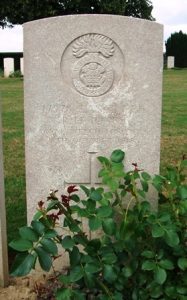
Robert Roberts, Private, 203746, Royal Welsh Fusiliers. Robert was the son of Jane Roberts, of Laburnum House, Betws Gwerful Goch. He worked as a Waggoner prior to the war, and enlisted at Corwen into the 4th Battalion, Royal Welsh Fusiliers on 6 February 1916. After fifteen months on home service, Robert embarked at Southampton on 3 August 1917 for France, and disembarked at Rouen the following day, before entraining for No 5 Infantry Base Depot. On 17 August he was posted to the 16th Battalion, Royal Welsh Fusiliers, which was at Ypres attached to 113 Brigade, 38th (Welsh) Division. The Division had just taken part in the capture of the Pilckem Ridge, suffering heavy casualties in doing so. After a brief rest the Division saw further action near Langemarck before it was relieved in September and moved to the area of Sailly-sur-la-Lys, where it held the line over the winter. On 21 March 1918 the Germans launched a massive offensive to the south, so the 38th Division was sent south to relieve the battered 47th and 2nd Divisions in the line north of Albert, where it remained until launching its offensive across the flooded Ancre Valley on 21 August 1918, as part of the great drive towards the Hindenburg Line. By 8 October 1918 the Division was near Villers-Outréaux, facing Mortho Wood, which had been heavily fortified by the Germans, and launched an assault with tank support against the wood. Robert was killed in action during heavy fighting that day. He was 22 years old and is buried in Bois-Des-Angles British Cemetery, Crevecoeur-Sur-L’escaut, France. Robert had an illegitimate child with Susannah Mary Meredith, of 32, Rose Place, Corwen and co-incidentally in 1920 she married Robert David Roberts, of Corwen.
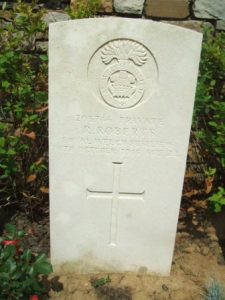
World War Two, 1939-1945
Thomas Holister Austin, Aircraftman, 1278350, Royal Air Force. Thomas was born on 28 June 1913, the son of Cadwaladr and Margaret Anne Austin, of Meadow View, Betws Gwerful Goch. He enlisted into the Royal Air Force Volunteer Reserve following the outbreak of war, and was posted to Java with 84 Squadron, RAF. The squadron was equipped with the Bristol Blenheim, and in 1940 had been sent from Iraq to Aden. It moved to Heliopolis in Egypt in September 1940, before moving to Greece soon afterwards. The squadron was moved to Palestine in April 1941, before returning to Iraq, then moved to the Far East. Thomas was among a section of the Squadron sent to Java, but the Japanese invaded the island on 28 February 1942, and when it fell on 12 March, he was taken into captivity and given the POW Number 2374. Thomas was among a number of men who arrived at Sandakan POW camp in April 1943. On 29 January 1945 Thomas left Sandakan among a large number of men on what is now known as the 1st Sandakan Death March. He was reported by the Japanese as having died of malaria near Paginatan on 17 February 1945, aged 32. Thomas has no known grave and is commemorated on the Singapore Memorial, Kranji.
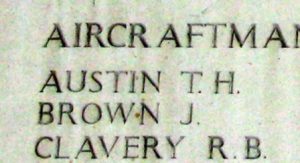
Kenrick Vaughan Evans, Fusiliers, 14248467, Lancashire Fusiliers. Kenrick was the son of Evan Vaughan Evans and Sarah Margaret Evans (nee Jones), of Alwen View, Betws Gwerful Goch. He enlisted into the army and was posted to the 2/6th Battalion, Lancashire Fusiliers. The battalion was a Territorial unit, and remained in Britain on home service throughout the war. Its main duties were home defence, but the battalion was also used to train recruits for service with the front-line TA battalions of the Lancashire Fusiliers. Kenrick died on active service in Norfolk on 22 July 1944, aged 31. His remains were conveyed home for burial in Capel y Gro, Betws Gwerful Goch.
Roy Jones, Able Seaman, Merchant Navy. Roy was the son of William Grey Jones and Mary Elizabeth Jones of Woodbank, Betws Gwerful Goch. He enlisted into the Merchant Navy and was posted aboard the steamship SS Empire Hawksbill. She was an American vessel, which had been transferred to the Merchant fleet in 1940. Early in the morning of 19 July 1942, Empire Hawksbill was sailing in Convoy OS-34, some 200 miles north of the Azores, when the convoy came under attack from the German submarine U-564, which fired a spread of four torpedoes at the convoy. The torpedoes struck two ships, Empire Hawksbill and Lavington Court, and sank both vessels. Roy was among 46 men lost during the sinking of Empire Hawksbill that morning. He was 29 years old and is commemorated on the Tower Hill Memorial, London.